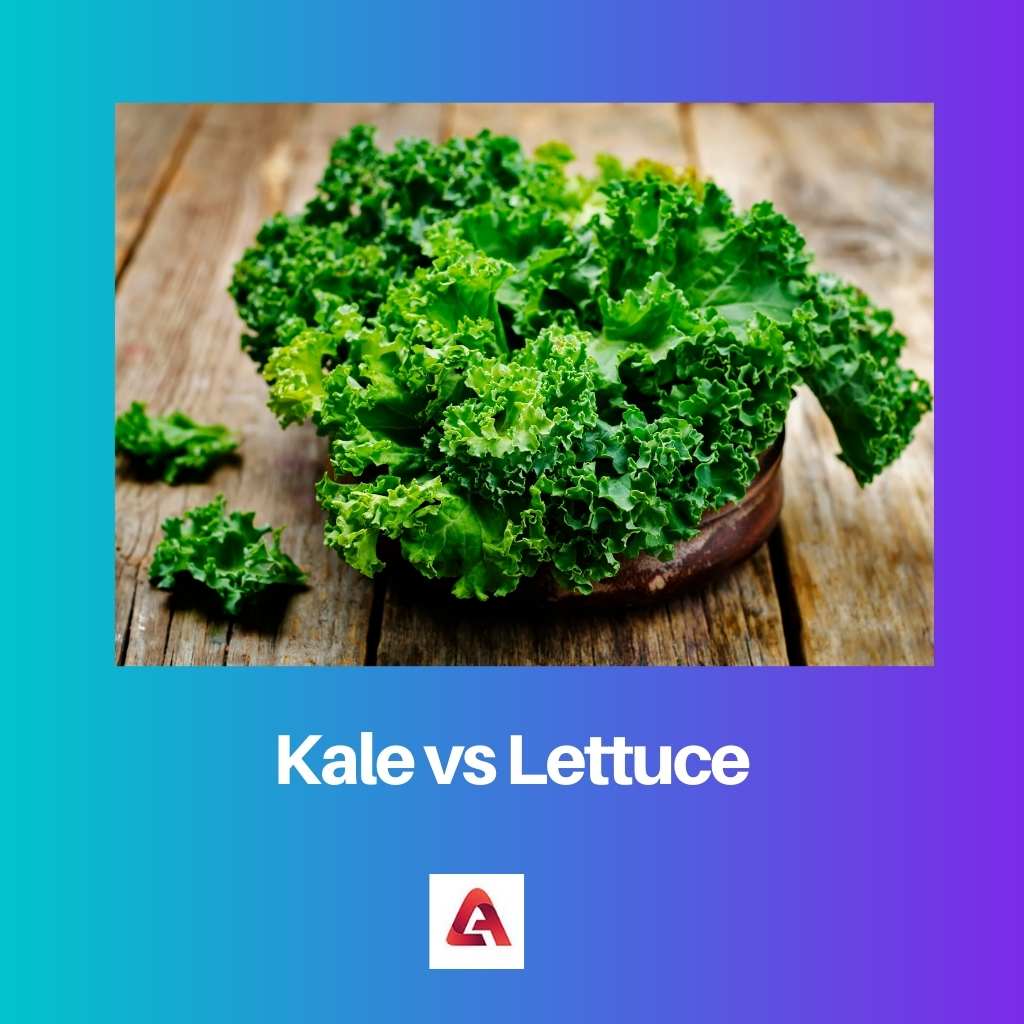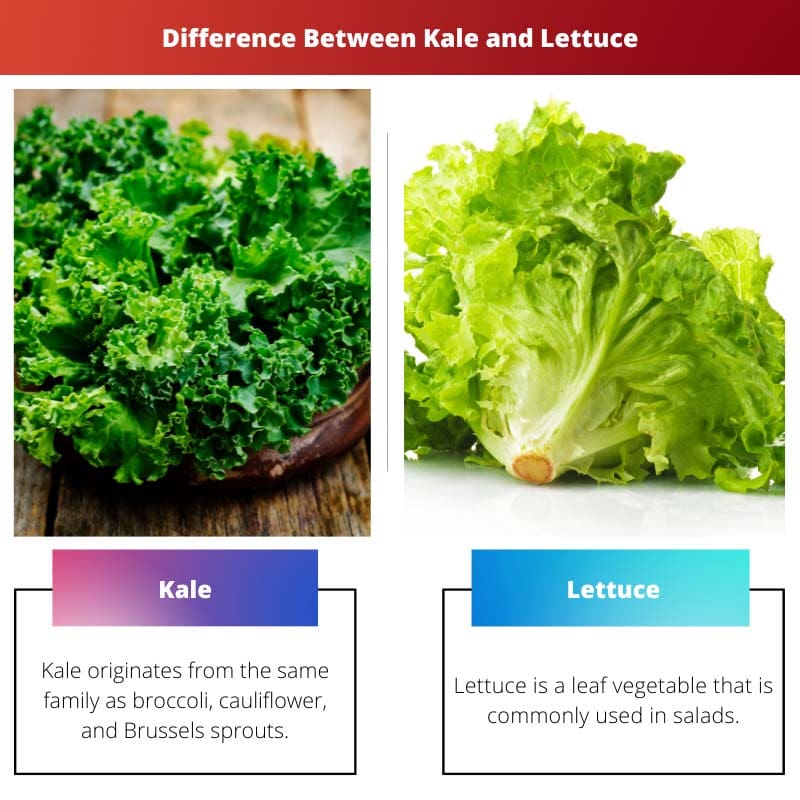Kale and lettuce are leafy green vegetables that can be consumed raw. We can add both these green vegetables to a range of food items, extending from salads to smoothies.
Both are high in fiber and have a low-calorie count. If you’re on a weight-loss program, they are an excellent item to have on your plate. Although, despite their similar uses, they are two very distinct veggies.
Key Takeaways
- Kale is a leafy green vegetable from the Brassica family, known for its high nutrient density and slightly bitter taste. At the same time, lettuce is a milder, more tender green from the Asteraceae family.
- Kale is richer in vitamins and minerals than lettuce, particularly vitamins K, A, and C.
- Both kale and lettuce are popular salad greens, but kale is used in cooked dishes due to its hardier texture and robust flavor.
Kale vs Lettuce
Kale is a type of cabbage that has leaves that are curly or smooth, and it is known for its dark green color. It has a slightly bitter taste and a chewy texture. Lettuce is a leafy green vegetable that comes in several varieties, including iceberg, romaine, and butterhead. It has a mild, slightly sweet flavor and a tender texture.

Kale originates from the same family as broccoli, cauliflower, and Brussels sprouts. Salads, soups, and smoothies are just a few of the ways kale is consumed. Kale is a kind of leaf cabbage with green or purple leaves that do not produce ahead.
Lettuce is a leaf vegetable that is commonly used in salads. It comes in a variety of styles, including romaine, crisphead, iceberg, and butterhead.
Lettuce’s health advantages are mostly due to its nutrient concentration. The health benefits of lettuce vary based on the variety consumed. All lettuces are classified into one of four types.
Comparison Table
| Parameters of Comparison | Kale | Lettuce |
|---|---|---|
| Meaning | Type of hardy cabbage | Plant with edible leaves |
| Nature | Cruciferous vegetable | Leafy vegetable |
| Consumption | Raw and cooked | Raw |
| Nutrient profile | Antioxidants, vitamins C and K | vitamins, minerals, dietary fiber |
| Fiber content | 3.6gms per 100gms | 1.2gm/100gm serving |
| Availability | Dry and cold climate | Spring and early summer |
What is Kale?
Kale, like other popular “cole crops,” belongs to the Brassica family. It may be cultivated from seed in the spring and young kale plants can be planted out early.
It is best cultivated in the autumn when temperatures are lower. When the leaves of kale develop in cold temperatures, the flavor improves.
Kale may be grown in a variety of ways in the yard, including standard garden beds, raised beds, and containers. It’s also a healthful addition to salads, stir-fries, omelets, casseroles, and other foods in the kitchen.
Kale is well-known for its health advantages. It has proven to be an easy way to add more leafy greens into a balanced diet, for example, in a smoothie, because it’s rich in antioxidants and vitamins A, C, and K, as well as high quantities of protein, fiber, iron, and magnesium.
Kale is a cold-weather champion that can withstand temperatures as low as the low 20s and as high as the upper teens. The sweet, nutty flavor of this very beneficial leafy green is enhanced by cooler temperatures.
It is high in fiber, antioxidants, calcium, vitamins C and K, iron, and a variety of other minerals that can aid in the prevention of a variety of ailments.
Kale is still a very healthy item to incorporate into a balanced diet. It may be roasted, stir-fried, steamed, or eaten raw, and it retains its consistency well in processing.
You can make smoothies with it, kale chips with it, wilt it into soup, mash it with potatoes, or make pesto with it.

What is Lettuce?
Lettuce is a leafy green vegetable that belongs to the daisy family of Asteraceae. Often, farmers cultivate lettuce as a leaf vegetable, but sometimes, farmers also cultivate it to obtain lettuce seeds and stems.
In ancient Egypt, lettuce was cultivated mainly to obtain oil from lettuce seeds and lettuce leaves as a source of food. Lettuce must be cultivated in low temperatures to delay the flowering process.
Lettuce contains fat, dietary fiber, proteins, carbohydrates, and sugars. Apart from that, the mineral content available in lettuce includes calcium, iron phosphorus, sodium, magnesium, potassium, zinc, and sodium.
It also contains vitamins such as folate, riboflavin, thiamine, niacin, Vitamin C, A, E, K, and B6.
By adding lettuce to your daily diet, you can absorb nutrients necessary to fight cancer, lower cholesterol levels, protect neurons, prevent inflammation, and control anxiety and insomnia.
Furthermore, there is a considerable number of antioxidants present in lettuce as well. There are a few different varieties of lettuce such as Iceberg lettuce, Romaine lettuce, Butterhead lettuce, etc.
Iceberg lettuce is one of them with a crispy texture and a mild taste. It has leaves with a greener shade on the outside and a whiter shade on the inside. It has a high content of choline.
Romaine lettuce is another variety with long and deep green leaves. It also has a crispy texture but a deeper taste. Romaine lettuce is a source of vitamins; rich in vitamin C, A B1, A, and B2.
While butterhead lettuce contains loose and larger leaves with a sweet taste and a soft texture. These leaves can be separated from the stem easily.
Further, loose-leaf lettuce has broad and curly leaves, which are loose and come with a tender taste and a crispy texture.

Main Differences Between Kale and Lettuce
- Kale is a tough cabbage with tall stems, huge leaves, and no compact head, whereas lettuce is a plant with broad, tasty green leaves.
- Kale is a cruciferous vegetable, while lettuce is a leafy vegetable.
- Kale can be consumed both raw and cooked, but lettuce is always consumed fresh mixed with salads, smoothies, sandwich toppings, etc.
- Kale consists of antioxidants, vitamins C and K, fiber, iron, and calcium, while lettuce contains lots of vitamins, minerals, dietary fiber, proteins, carbohydrates, and sugars.
- Kale’s fiber content may clean the stomach like a broom, pushing waste out. Its fiber content is approximately 3.6 grams per 100 grams. Lettuce, on the other hand, has a low fiber level, with only 1.2gm/100g serving.
- Kale likes a dry and cold climate. In India, it can be grown during winter. Seeds are sown in October-November. While Spring and early summer may be the best time of year for farm-fresh lettuce.

- https://applbiolchem.springeropen.com/articles/10.1007/s13765-014-4081-5
- https://www.mdpi.com/1338934
